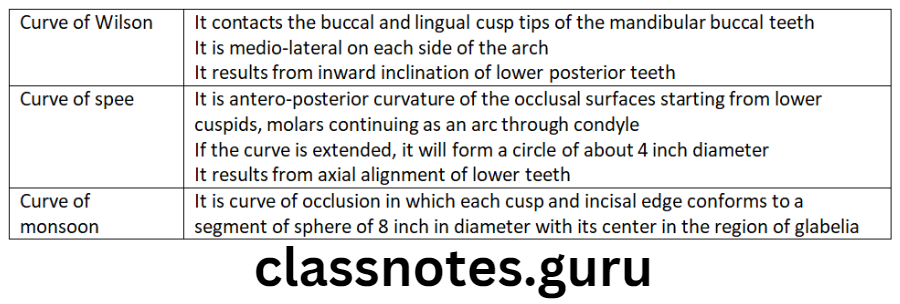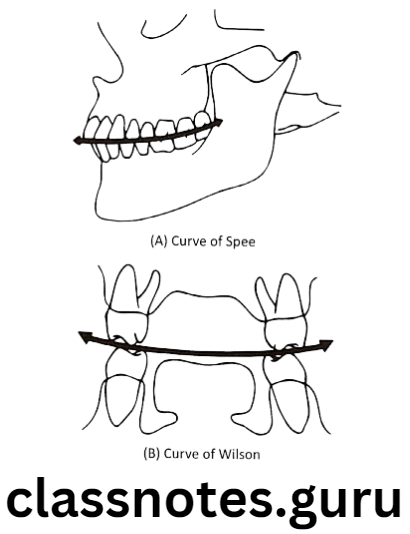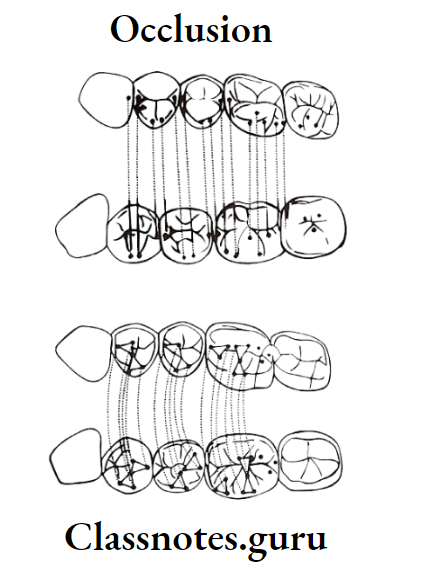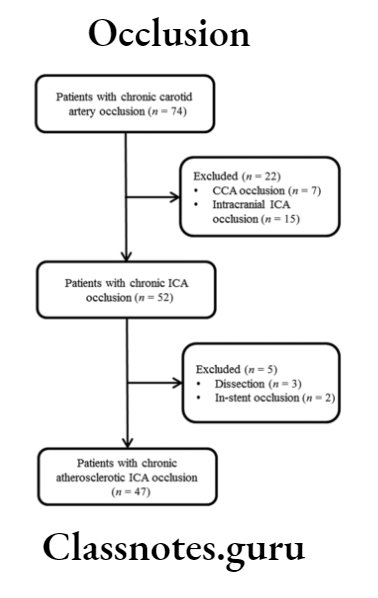Occlusion – Basic Concepts Definitions
- Centric relation
- It is the relation of the mandible to the maxilla when the condyles are in the most superior and retruded position in their glenoid fossa with the articular disc properly interposed.
- Centric Occlusion:
- It is that position of the mandibular condyle when the teeth are in maximum intercuspation
- Occlusion
- It is the normal relation of the occlusal inclined planes of the teeth when the jaws are closed.
- Malocclusion
- It refers to any deviations from normal occlusion
- Balanced occlusion
- An occlusion in which balanced and equal contacts are maintained throughout the entire arch during all excursions of the mandible
Occlusion – Basic Concepts Important Notes
- Keys of occlusion
- Molar interarch relationship
- Mesiodistal crown angulation
- Labio-lingual crown inclination
- Absence of rotation
- Tight contacts
- Curve of Spee
- Bolton’s ratio
- Curves of occlusion

Occlusion – Basic Concepts Short Essays
Question 1. Curves of Occlusion.
Answer.
The curve of Spee: It is antero-posterior curvature of the occlusal surfaces beginning at the tip of the lower cuspid and following the cusp tips of the bicuspids and molars continuing as an arch through the condyle
Value Of Occlusion: Forms a circle of 4-inch diameter
Significance Of Curve Of Spee: Shows axial alignment of lower teeth
- The long axis of each lower tooth is aligned parallel to its arc of closure around a condylar axis
- Gradual mesial tilting of teeth is seen
Curve Of Wilson:
- Contacts the buccal and lingual cusp tips of mandibular buccal teeth
- It is a mediolateral curve
Significance Of Curve Of Wilson:
- Provide resistance to masticatory forces
- Prevent food from going past the occlusal table
Curve Of Monson:
- Obtain by extending the curve of Spee and curve of Wilson to all cusps and incisal edges

Question 2. Arrangement of teeth.
Answer.
Cusp-Fossa Occlusion:
- The stamp cusp of one tooth occludes in a single fossa of a single opponent
- Upper stamp cusps fit into all except the mesial fossae of the lower teeth
- Lower stamp cusps fit into all the upper fossae except distal ones of bicuspids
Cusp-Embrasure Occlusion:
- Each tooth occludes with two opposing teeth

Read And Learn More: Orthodontics Short And Long Essay Question And Answers
Question 3. Functional Occlusion.
Answer.
- It refers to tooth contacts that occur in the segment of the arch towards which the mandible moves
- Also called working side occlusion
Types Of Functional Occlusion:
Lateral Functional Occlusion:
- Tooth contacts occur on canines & posteriors on the working side.
Canine-guided occlusion:
- Working side
- Upper & lower canine contact with each other
- Disclusion of posteriors
- Balancing side
- Disclusion of posteriors
Group Lateral:
- Canine guided occlusion
- Occlusion of certain posterior teeth occurs on the working side.
Protrusive Functional Occlusion
- Eccentric contacts occur during the forward movement of the mandible
- 6 mandibular anterior contact palatal inclines of maxillary anterior while posterior dis occlude.
Question 4. Centric relation and centric occlusion.
Answer.
Centric Relation:
Definition: It is the relation of the mandible to the maxilla when the condyles are in the most superior and retruded position in their glenoid fossa with the articular disc properly interposed.
Synonyms Of Centric Relation:
- Ligamentous position
- Terminal hinge position
Centric Occlusion:
Definition: It is the position of the mandibular condyle when the teeth are in maximum intercuspation
Synonyms Of Centric Occlusion:
- Inter-cuspal position
- Convenience occlusion
Significance Of Centric Occlusion:
- The perfect harmony between teeth, TMJ, and neuromuscular system
- Placement of mandible in an unstrained position
Acquired Occlusion:
- Maximum intercuspation obtained without condyles in centric relation
Synonyms Of Acquired Occlusion:
- Maximum intercuspation
- Habitual intercuspation
Question 5. Keys of Occlusion.
Answer.
By Andrew in the 1970’s
Key 1 – Molar interarch relationship:
- The mesiobuccal cusp of the upper first molar should occlude in the groove between the mesial and medial buccal cusp of the lower first molar
- The mesiolingual cusp of the upper first molar should occlude in the central fossa of the lower first molar
- A distal marginal ridge of the upper first molar should occlude with a mesial marginal ridge of lower of lower second molar
Key – 2: Mesiodistal crown angulation:
- The gingival part of the long axis of the clinical crown must be distal to the occlusal part of it.
Key – 3: Labio-Lingual Crown Inclination:
- If the gingival area of the crown is more lingually placed than the occlusal area – It is called positive crown inclination
- If the gingival area of the crown is more labially placed than the occlusal area – It is called Negative crown inclination
- Positive – Maxillary incisors
- Negative – Mandibular incisors, Maxillary and mandibular posteriors
Key 4: Absence of Rotation
- There should not be any rotation of teeth
- Rotated posteriors – occupy more space
- Rotated interiors – occupy less space
Key 5 – Tight contacts:
- There should be tight contact between teeth
Key 6 – Curve of Spee:
- The curve of Spee should not exceed 1.5mm
Key 7 – Bolton’s Analysis:
- Gives the mesiodistal width of maxillary and mandibular posteriors.

Occlusion – Basic Concepts Short Questions And Answers
Question 1. Define occlusion, balanced occlusion and malocclusion.
Answer.
Occlusion:
- By Angle
- It is the normal relation of the occlusal inclined planes of the teeth when the jaws are closed
- It is a complete phenomenon involving teeth, PDL, jaws, TMJ, muscles, and the nervous system
Balanced Occlusion:
- An occlusion in which balanced and equal contacts are maintained throughout the entire arch during all excursions of the mandible
Malocclusion:
- It refers to any deviations from normal occlusion
Question 2. Types of cusps.
Answer.
Centric Holding Cusps:
- Facial cusps of mandibular posteriors and
- Palatal cusps of maxillary posteriors are centric holding cusps.
- They occlude into the central fossa and marginal ridges of opposing teeth
- Also called “stamp cusps”
Non-Supporting Cusps:
- Buccal cusps of maxillary posteriors & Lingual cusps of mandibular posteriors are non-supporting cusps.
- Guides mandible during lateral excursions
- Shear food during mastication
- Also called shearing or guiding cusps
Question 3. Roth’s keys of functional occlusion.
Answer.
- Roth’s keys of functional occlusion are:
- Key 1 – Coincidence of intercuspal position and retruded contact position
- Key 2 – Maximum and stable cusp to fossa contacts throughout the buccal segments
- Key 3 – Disclusion of the posterior teeth in mandibular protrusion by even contacts on the incisors
- Key4 – Lateral movements of the mandible are guided by the working side canines with the disclusion of all the other teeth on both working and non-working sides
Question 4. Curve of Spee
Answer.
It is antero-posterior curvature of the occlusal surfaces beginning at the tip of the lower cuspid and following the cusp tips of the bicuspids and molars continuing as an arc through the condyle
Value: Forms a circle of 4-inch diameter
Significance: Shows axial alignment of lower teeth
- The long axis of each lower tooth is aligned parallel to its arc of closure around a condylar axis
- Gradual mesial tilting of teeth is seen
Occlusion – Basic Concepts Viva Voce
- Facial cusps of mandible and palatal cusps of maxillary posterior teeth are centric holding cusps
- Maxillary buccal and mandibular lingual cusps are non-supporting cusps
- Cusp fossa occlusion is tooth to tooth-to-tooth arrangement
- Cusp embrasure occlusion is tooth to two teeth arrangement
- The curve of Spee is antero-posterior curvature
- The curve of Wilson is mediolateral on each side
- The curve of Monsoon is obtained by extending the curve of Spee and the curve of Wilson
- Lateral functional occlusion is contact occurring on canines and posterior teeth on the side towards which the mandible moves
- Protrusive functional occlusion includes eccentric contact occurring when the mandible moves forward
- Disclusion of posterior teeth is brought about by condylar guidance and incisal guidance
- Andrew gave six keys to the occlusion
- According to Andrew curve of Spee should not exceed 1.5mm
